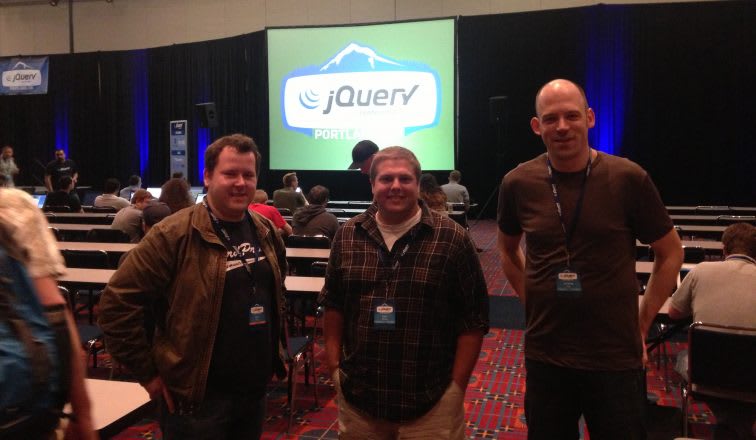 WordCamp Chicago starts this Friday, and runs until Sunday, June 30. I had the pleasure of organizing this camp, before starting at 10up. Even before I joined the team, I was eager to invite some of the experts at 10up, and was thrilled to welcome both Senior Web Engineer Carl Danley and Director of Web Engineering Jeremy Felt as speakers. Jeremy will discuss the benefits of using Vagrant as a local development platform; Carl will present JavaScript performance techniques. In addition to organizing, I’ll be co-teaching the HTML & CSS Foundations class and participating in a couple of panels. Hope to see you there!
WordCamp Chicago starts this Friday, and runs until Sunday, June 30. I had the pleasure of organizing this camp, before starting at 10up. Even before I joined the team, I was eager to invite some of the experts at 10up, and was thrilled to welcome both Senior Web Engineer Carl Danley and Director of Web Engineering Jeremy Felt as speakers. Jeremy will discuss the benefits of using Vagrant as a local development platform; Carl will present JavaScript performance techniques. In addition to organizing, I’ll be co-teaching the HTML & CSS Foundations class and participating in a couple of panels. Hope to see you there!
Blog
 This weekend I’ll be traveling to Montreal, Canada for the first time to speak at WordCamp Montreal, which is also being sponsored by 10up. I’ll be reprising “What You Missed in Computer Science”, which applies some key Computer Science tools to WordPress. Team 10up has had the pleasure of collaborating with a number of Canadian partners, helping Postmedia launch the new Canada.com and more recently working with Shaw Media to relaunch Global News. We’re proud to give back to the Canadian community through our sponsorship and support. I’m personally looking forward to Matt Mullenweg’s town hall and WordPress.com VIP wrangler Mo Jangda’s presentation.
This weekend I’ll be traveling to Montreal, Canada for the first time to speak at WordCamp Montreal, which is also being sponsored by 10up. I’ll be reprising “What You Missed in Computer Science”, which applies some key Computer Science tools to WordPress. Team 10up has had the pleasure of collaborating with a number of Canadian partners, helping Postmedia launch the new Canada.com and more recently working with Shaw Media to relaunch Global News. We’re proud to give back to the Canadian community through our sponsorship and support. I’m personally looking forward to Matt Mullenweg’s town hall and WordPress.com VIP wrangler Mo Jangda’s presentation.
Inspiration at jQuery Conference Portland
Last week, Jeremy Felt, Carl Danley, and I attended jQuery Conference Portland 2013. The Conference was a great chance to connect with and listen to web professionals experienced with jQuery.

From keynotes explaining the jQuery server infrastructure – an elegant use of Github and Grunt.js enabling websites to commit using pull requests – to speakers like Patrick Camacho, who detailed Twitter’s use of Backbone for Crashlytics (Carl’s conversation with Patrick about Backbone design patterns was his highlight), every speaker offered well-informed, broad, and fascinating content. In addition to solid presentations consistently interlaced with humor, participants had the chance to pick speakers’ brains.
I had the opportunity to speak before my largest audience on the importance of Unit Testing in a presentation I titled “Minutes Now Will Save Hours Later.” In contrast to presentations I’ve offered at other conferences, I’m still getting questions nearly one week later. It’s wonderful to have such an interested, interactive, and enthused crowd!
Read More on Inspiration at jQuery Conference Portland
Documentation teams from some of the web’s largest open source projects have converged in Cincinnati this week to share knowhow at the Open Help Conference and Sprints. Not to be left out, I’ll be attending along with 9 other WordPress docs team contributors.
This conference affords docs team contributors a great opportunity to get a lot of work done in a short period, and a chance to meet-up in person (the first time, for many of us). The WordPress delegation will be holding three, day long sprints, where we’ll tackle a roadmap for the WordPress Codex, analyze survey results and, of course, write much-needed documentation. Big thanks to Siobhan McKeown for bringing all of us together!
Injecting Ads into the Jetpack Carousel
This is really neat!
Kind words from WordPress.com VIP‘s rock star team after deploying our new ad integration extension to Jetpack’s Carousel. Built for 9to5mac.com, this extension appends a custom image to the full screen carousel modal. We’re excited to share it with the WordPress community, along with a few cautions and insights.
Rules are rules: no AdSense
If you were hoping to inject AdSense ads, we’re sorry to disappoint: AdSense policies clearly stipulate that an ad may not be “Displayed in pop-ups or pop-unders.” You may, of course, be able to leverage our approach for other, more forgiving ad networks. We envision the typical use case will involve an internal “house” ad image.
Hooking into Jetpack with JavaScript
Because the modal Jetpack Carousel is generated entirely by JavaScript, classic WordPress PHP API hooks do not apply. Fortunately, JetPack provides 2 JavaScript hooks: jp_carousel.afterOpen and jp_carousel.beforeClose. We hooked into afterOpen – which fires every time the carousel is generated – on line 14 of carousel-ads.js:
$( document.body ).on( 'jp_carousel.afterOpen', SELF.insertAd );
Aaron Holbrook joins 10up

I’m Aaron Holbrook, and I’m incredibly excited to be 10up’s newest Web Engineer, claiming the mantle as the first Chicago 10upper!
I’ve crafted websites since 1998, when I was convinced my GeoCities site would light the world on fire. Since resetting my expectations, I found a passion for HTML, CSS and PHP and even built my own content management system in 2004, only to stumble upon WordPress shortly thereafter.
After earning a degree in Computer Science and Mathematics from Augustana College, I became the full-time “webmaster” for a hospital. After spending 5 years managing content, I realized that my passion was building, not just managing, websites. Before leaving in 2011, I rebuilt the entire hospital website on WordPress.
WP the People: 10up Hacks the White House
Back in February, we applied to We the People‘s second ever White House Hackathon. The event is an open-ended civic hack day where developers of all stripes from across the United States are invited to create applications in languages like Python and JavaScript. The purpose of the event was to create resources for websites, smartphones and other platforms that build on We the People. As a Senior Web Engineer, I had the privilege of representing WordPress at the White House, alongside fellow 10upper Christopher Cochran and Automattic‘s Mo Jangda. Given just how small and selective the event was, we were deeply honored to be accepted and participate.
Come Work With Us: WordPress developer with a front-end focus
At 10up, we say we’re always hiring, and it’s true. We’re always looking for WordPress engineers and web strategists, but right now we’ve especially got our eyes on hiring another WordPress developer with a focus on the front-end. We offer a competitive full-time salary and benefits. If you’re interested, send a resumé and code samples (like a WordPress theme) to [email protected].
Read More on Come Work With Us: WordPress developer with a front-end focus
Opening a new tab or window: usability considerations
Have you ever asked your web developer to open a link in a new tab or window? Generally, this is accomplished by adding a target="_blank" attribute to a link. Let’s consider the usability implications.
The rationale is almost always founded in a desire to keep the audience engaged with your content longer, or a concern about usability (for example, keeping the reader losing his or her bearings). The overwhelming finding from user experience researchers*, however, is that new windows/tabs should be avoided when simply opening new web pages. However, there are some appropriate use cases: opening a non-HTML document (web page) like a large image, video, audio, or other media, or to avoid interrupting an important linear process like a checkout. Even with these exceptions, however, there are friendlier alternatives like tool-tips and lightboxes.
In fact, the target="" attribute was actually deprecated (being phased out) from the HTML specifications until HTML5. As of HTML5, the W3C guidelines stipulate that it is no longer deprecated because it is deemed “useful in Web applications, e.g. in conjunction with iframe.”
Read More on Opening a new tab or window: usability considerations
Editing WordPress’s Visual Editor
These are the slides from a talk I gave at the 2011 WordCamps (WordPress conferences) in Chicago, Philly, and Orlando. I consider this a “sequel” to a broader talk on editing the WordPress administrative experience that I like to think I pioneered in 2010 at a few WordCamps, including Chicago and Mid-Alantic, which several new speakers now seem to be running with.
WordPress’s visual content editor (TinyMCE) is, in many ways, at the heart of WordPress’s content management experience. It’s where editors spend most of their time, and where content is crafted to appear on the front end of your site. Like most of WordPress, the editor can be customized to be both more powerful and more specific to the needs of an individual site or client. This presentation covers topics including custom editor stylesheets based on post type, modifying and removing buttons from the editor, and even creating your own custom buttons for the TinyMCE toolbar. It even covers brand new WordPress 3.3 techniques introduced with the new wp_editor function.
